
Concept explainers
- (a) (a.1)
Interpretation:
Number of signals expected in each of the following compounds in
Concept introduction:
The number of signals in
For each set of chemically equivalent protons, there will be one signal. For example, the
- (a) (a.1)
Answer to Problem 47P
Compound (1) will show 5 signals in its
Explanation of Solution
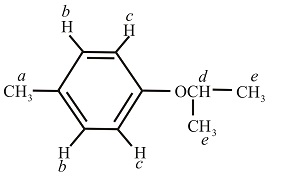
The set of chemically equivalent protons in a compound produces a separate signal in
(a.2)
Interpretation:
Number of signals expected in each of the following compounds in
Concept introduction:
The number of signals in
For each set of chemically equivalent protons, there will be one signal. For example, the
(a.2)
Answer to Problem 47P
Compound (2) will show 5 signals in its
Explanation of Solution
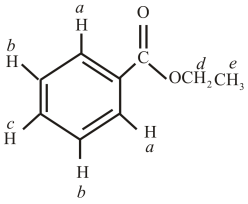
The set of chemically equivalent protons in a compound produces a separate signal in
(a.3)
Interpretation:
Number of signals expected in each of the following compounds in
Concept introduction:
The number of signals in
For each set of chemically equivalent protons, there will be one signal. For example, the
(a.3)
Answer to Problem 47P
Compound (3) will show 4 signals in its
Explanation of Solution
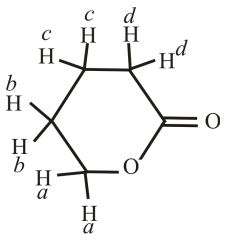
The set of chemically equivalent protons in a compound produces a separate signal in
(a.4)
Interpretation:
Number of signals expected in each of the following compounds in
Concept introduction:
The number of signals in
For each set of chemically equivalent protons, there will be one signal. For example, the
(a.4)
Answer to Problem 47P
Compound (4) will show 2 signals in its
Explanation of Solution
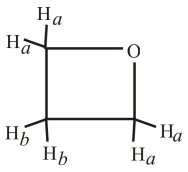
The set of chemically equivalent protons in a compound produces a separate signal in
(a.5)
Interpretation:
Number of signals expected in each of the following compounds in
Concept introduction:
The number of signals in
For each set of chemically equivalent protons, there will be one signal. For example, the
(a.5)
Answer to Problem 47P
Compound (5) will show 3 signals in its
Explanation of Solution
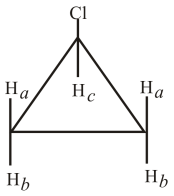
The set of chemically equivalent protons in a compound produces a separate signal in
(a.6)
Interpretation:
Number of signals expected in each of the following compounds in
Concept introduction:
The number of signals in
For each set of chemically equivalent protons, there will be one signal. For example, the
(a.6)
Answer to Problem 47P
Compound (6) will show 3 signals in its
Explanation of Solution
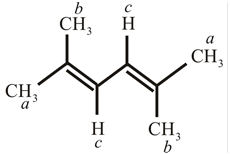
The set of chemically equivalent protons in a compound produces a separate signal in
- (b) (b.1)
Interpretation:
Number of signals expected in each of the following compounds in
Concept introduction:
The signals in the spectrum of a compound are proportional to the number of carbons that are present in the different environment within the molecule. The carbon which is present in the electron-rich environment shows a signal at a lower frequency and vice-versa. Therefore, the carbons that are present nearest to the electron-withdrawing groups produce a high-frequency signal.
- (b) (b.1)
Answer to Problem 47P
Compound (1) will show 7 signals in its
Explanation of Solution
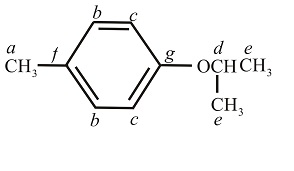
The set of chemically equivalent carbon in a compound produces a separate signal in
(b.2)
Interpretation:
Number of signals expected in each of the following compounds in
Concept introduction:
The signals in the spectrum of a compound are proportional to the number of carbons that are present in the different environment within the molecule. The carbon which is present in the electron-rich environment shows a signal at a lower frequency and vice-versa. Therefore, the carbons that are present nearest to the electron-withdrawing groups produce a high-frequency signal.
(b.2)
Answer to Problem 47P
Compound (2) will show 7 signals in its
Explanation of Solution
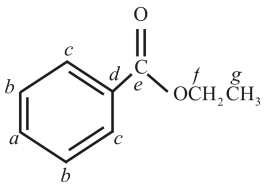
The set of chemically equivalent carbon in a compound produces a separate signal in
(b.3)
Interpretation:
Number of signals expected in each of the following compounds in
Concept introduction:
The signals in the spectrum of a compound are proportional to the number of carbons that are present in the different environment within the molecule. The carbon which is present in the electron-rich environment shows a signal at a lower frequency and vice-versa. Therefore, the carbons that are present nearest to the electron-withdrawing groups produce a high-frequency signal.
(b.3)
Answer to Problem 47P
Compound (3) will show 5 signals in its
Explanation of Solution
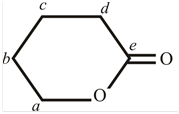
The set of chemically equivalent carbon in a compound produces a separate signal in
(b.4)
Interpretation:
Number of signals expected in each of the following compounds in
Concept introduction:
The signals in the spectrum of a compound are proportional to the number of carbons that are present in the different environment within the molecule. The carbon which is present in the electron-rich environment shows a signal at a lower frequency and vice-versa. Therefore, the carbons that are present nearest to the electron-withdrawing groups produce a high-frequency signal.
(b.4)
Answer to Problem 47P
Compound (4) will show 2 signals in its
Explanation of Solution
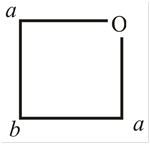
The set of chemically equivalent carbon in a compound produces a separate signal in
(b.5)
Interpretation:
Number of signals expected in each of the following compounds in
Concept introduction:
The signals in the spectrum of a compound are proportional to the number of carbons that are present in the different environment within the molecule. The carbon which is present in the electron-rich environment shows a signal at a lower frequency and vice-versa. Therefore, the carbons that are present nearest to the electron-withdrawing groups produce a high-frequency signal.
(b.5)
Answer to Problem 47P
Compound (5) will show 2 signals in its
Explanation of Solution
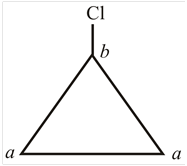
The set of chemically equivalent carbon in a compound produces a separate signal in
(b.6)
Interpretation:
Number of signals expected in each of the following compounds in
Concept introduction:
The signals in the spectrum of a compound are proportional to the number of carbons that are present in the different environment within the molecule. The carbon which is present in the electron-rich environment shows a signal at a lower frequency and vice-versa. Therefore, the carbons that are present nearest to the electron-withdrawing groups produce a high-frequency signal.
(b.6)
Answer to Problem 47P
Compound (6) will show 4 signals in its
Explanation of Solution
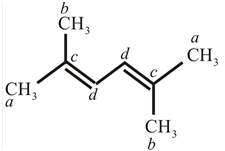
The set of chemically equivalent carbon in a compound produces a separate signal in
Want to see more full solutions like this?
Chapter 14 Solutions
Student's Study Guide and Solutions Manual for Organic Chemistry
- A covalent bond is the result of the a) b) c) d) e) overlap of two half-filled s orbitals overlap of a half-filled s orbital and a half-filled p orbital overlap of two half-filled p orbitals along their axes parallel overlap of two half-filled parallel p orbitals all of the abovearrow_forwardCan the target compound at right be efficiently synthesized in good yield from the unsubstituted benzene at left? starting material target If so, draw a synthesis below. If no synthesis using reagents ALEKS recognizes is possible, check the box under the drawing area. Be sure you follow the standard ALEKS rules for submitting syntheses. + More... Note for advanced students: you may assume that you are using a large excess of benzene as your starting material. C T Add/Remove step X ноarrow_forwardWhich one of the following atoms should have the largest electron affinity? a) b) c) d) 으으 e) 1s² 2s² 2p6 3s¹ 1s² 2s² 2p5 1s² 2s² 2p 3s² 3p² 1s² 2s 2p 3s² 3p6 4s2 3ds 1s² 2s² 2p6arrow_forward
- All of the following are allowed energy levels except _. a) 3f b) 1s c) 3d d) 5p e) 6sarrow_forwardA student wants to make the following product in good yield from a single transformation step, starting from benzene. Add any organic reagents the student is missing on the left-hand side of the arrow, and any addition reagents that are necessary above or below the arrow. If this product can't be made in good yield with a single transformation step, check the box below the drawing area. Note for advanced students: you may assume that an excess of benzene is used as part of the reaction conditions. : ☐ + I X This product can't be made in a single transformation step.arrow_forwardPredict the major products of this organic reaction:arrow_forward
- Name the family to which each organic compound belongs. The first answer has been filled in for you. compound CH₂ || CH3-C-NH2 0 ။ CH3-C-CH₂ CH=O–CH=CH, CH₂ HO CH2-CH2-CH-CH3 family amine Darrow_forward1b. Br LOHarrow_forwardI would like my graphs checked please. Do they look right? Do I have iodine and persulfate on the right axis ?arrow_forward
 Organic ChemistryChemistryISBN:9781305580350Author:William H. Brown, Brent L. Iverson, Eric Anslyn, Christopher S. FootePublisher:Cengage Learning
Organic ChemistryChemistryISBN:9781305580350Author:William H. Brown, Brent L. Iverson, Eric Anslyn, Christopher S. FootePublisher:Cengage Learning

